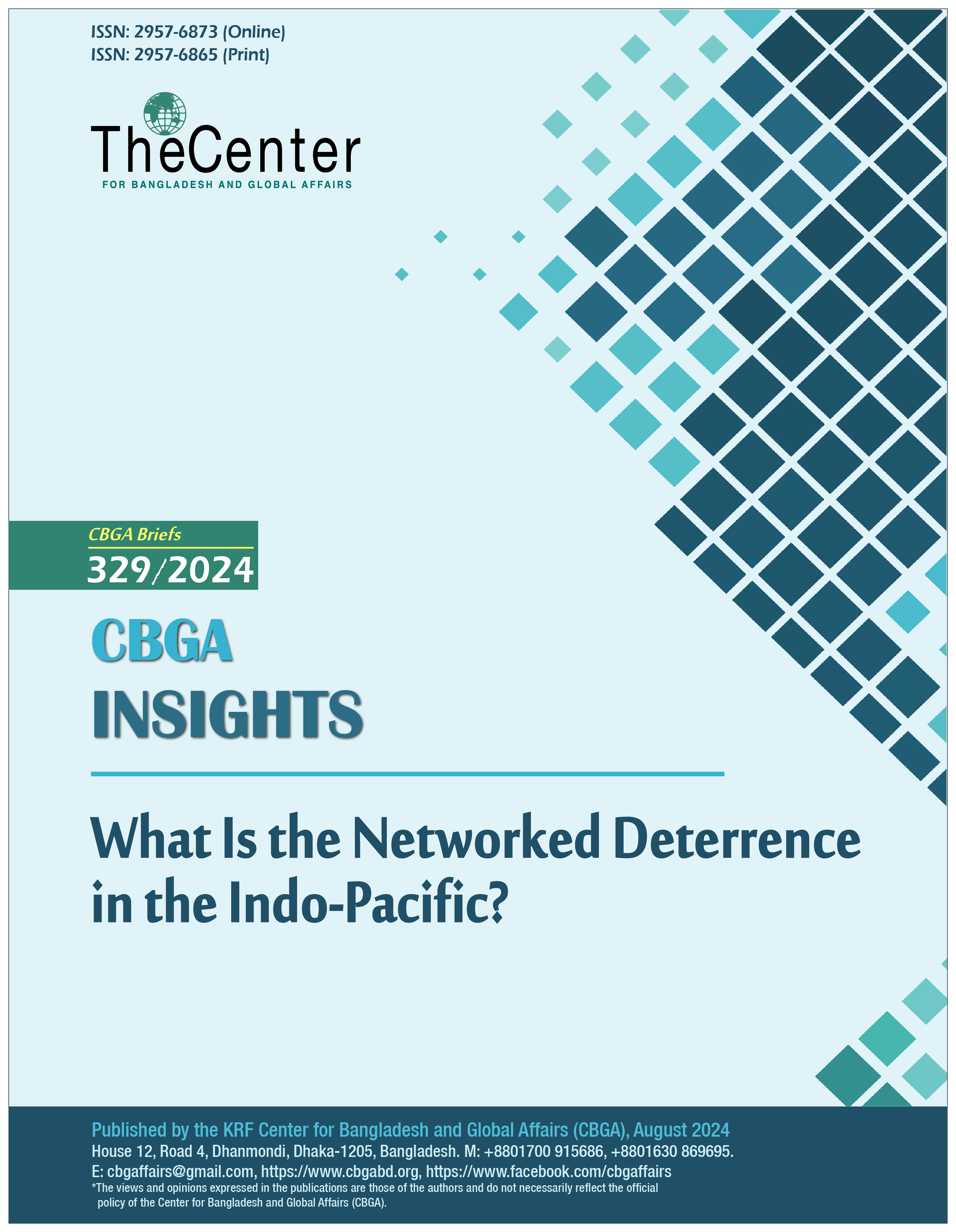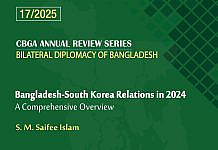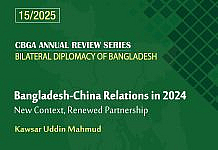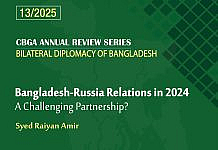
Indo-Pacific region is witnessing a new type of deterrence known as the networked Deterrence. The region with its vast resources draws a huge attention on this issue in terms of understanding its security and development. The Indo-Pacific region is home to 65% of the world’s population, which accounts for 62% of the world’s gross domestic product (GDP) and 46% of international trade. The region is also very important for the transportation of goods and energy, overseeing half of the world’s maritime transport. In terms of geographical mapping, different countries have varying perspectives on the geographical extent of the region. For example, the US defines the region as stretching from its Pacific coastline to South Asia, while Australia’s focus is from the northeastern side of the Indian Ocean to the Southwest Pacific.
The concept of “networked deterrence” embodies a security framework characterized by interconnected bi-, mini-, and multilateral associations, both formal and informal. In the Indo-Pacific, a novel security structure has emerged in response to the challenges posed by China’s escalating power and the diminishing influence of the US, prompting regional powers to bolster their individual and collective military capabilities. Consequently, the regional security paradigm has transitioned away from Cold War-era hub-and-spoke arrangements towards a more decentralized model often described as “latticework” security arrangements. In this model, minilateral groupings overlay traditional bilateral and multilateral relationships, resulting in a networked and more inclusive security architecture.
The idea of networked deterrence figures predominantly in the US security posture in the Indo-Pacific, as many believe the era of US unipolarity in Asia is over. The 2022 “Indo-Pacific Strategy of the United States” advocates for “integrated deterrence,” emphasizing collaborative approaches to mitigate security threats in the region. This call for collective efforts implies a recognition by the US that it no longer dominates a unipolar world. Therefore, the US is striving to strike a balance between its declining influence compared to a rising China by cultivating new alliances with regional partners across different levels.
The US has actively pursued the establishment of networked deterrence, a commitment evident in recent developments. The US Secretary of Defense Lloyd Austin has highlighted allied networking as a pivotal element of integrated deterrence. This approach aligns with the objectives outlined in the 2018 US National Defense Strategy, which aimed for seamless integration of national power elements and coordinated actions with allies to facilitate proactive and adaptable deployment of the Joint Force across theaters. Similarly, the 2022 National Defense Strategy emphasizes integrated deterrence as its cornerstone, emphasizing allies and partners as the linchpin of this strategy. Additionally, the US introduced the Pacific Deterrence Initiative (PDI) in 2023, aimed at enhancing the defense, security capabilities, strength, and collaboration among allies and partners. With a budget allocation of $34.4 billion from fiscal years 2021 to 2027, the PDI underscores the US’s commitment to bolstering collective deterrence against potential threats. In essence, networked deterrence not only aligns with US preferences for deterring Chinese aggression but also reinforces the integrated deterrence framework outlined in the current US defense strategy, lending credibility to collective deterrent measures.
Regional partners are already actively collaborating with the US to enhance their own capabilities and improve interoperability, aiming to deter emerging threats, particularly from China. Both the US and Australia widely agree that coordinated efforts among allied armed forces are crucial for revitalizing conventional deterrence and defense. Australia’s 2020 Defense Strategic Update anticipated the US concept of integrated deterrence by expressing Canberra’s support for a collective deterrence strategy. Minister for Defense Linda Reynolds emphasized that “deterrence is a joint responsibility for a shared purpose — one that no country, not even the US, can undertake alone.” Additionally, bilateral security partnerships among regional allies are strengthening under the broader theme of networked deterrence. Recent developments such as the reconciliation between Japan and South Korea, reciprocal defense arrangements between Australia and Japan, and the deepening defense collaboration between Japan and the Philippines all signify a growing security partnership among regional partners who share common platforms with the US in the region.
Different trilateral meetings and partnerships involving the US and its allies also illustrate the growing support for networked deterrence. For instance, during the 2022 US-Japan-Republic of Korea Trilateral Partnership for the Indo-Pacific, leaders emphasized on building an “unprecedented level of trilateral coordination” to strengthen deterrence in the region. Similarly, other trilateral arrangements, such as the US, Japan, and Australia Trilateral Defense Ministers Meeting, and the US, Japan, and the Philippines Trilateral Defense Policy Dialogue, further solidify the framework of networked deterrence in the Indo-Pacific.
Most importantly, several minilateral security groups have been established to strengthen networked deterrence. The foremost example is the QUAD, consisting of Australia, India, Japan, and the US, which was revitalized in 2017 and now conducts regular summit-level meetings. Another noteworthy minilateral initiative is AUKUS, announced in 2021, which aims to enhance defense technology cooperation among already closely aligned allies Australia, the United Kingdom, and the US. Unlike focusing on norm building, AUKUS prioritizes bolstering military capabilities.
Moreover, increasing interoperability among US allies and partners is already visible under networked deterrence. A multitude of major interoperability training exercises and military drills in the Indo-Pacific region have long supported this agenda of alliance integration. These exercises include Talisman Sabre, Indo-Pacific Endeavour, Pitch Black, Indo-Pacific Command’s Pacific Pathways, and multilateral exercises such as the US-led Rim of the Pacific and Cobra Gold hosted by Thailand. The recent addition of Exercise Malabar, now involving all four Quad nations, underscores this trend. AUKUS SSN stands out as a notable example, particularly as it drives efforts to overcome barriers to greater defense industrial integration. Collectively, these initiatives aim to enhance the military capabilities and networks of nations, thereby strengthening collective deterrence.
While the US no longer maintains absolute primacy in this evolving multipolar regional security landscape, these developments nonetheless serve to promote US interests by reinforcing a favorable regional balance of power and enhancing collective deterrence against China.
In response, Beijing does not have any stated policies like networked deterrence in the region. However, China adopts a multifaceted approach to achieve its strategic objectives. The People’s Liberation Army (PLA) documents delineate a deterrence posture that integrates economic, diplomatic, informational, and military resources. Notably, China’s military budget has experienced significant growth, increasing from a modest $14.6 billion in 2000 to a substantial $229 billion in 2022. It has prioritized substantial investments in military modernization and advanced anti-access/area denial (A2/AD) systems. Now, China has world’s largest navy in terms of the number of ships and submarines, comprising a total battle force of 370 vessels. Additionally, Beijing employs a spectrum of tactics, ranging from influence campaigns and information operations to political warfare at the low end, to grey zone tactics, economic leverage, cyber-attacks, and coercive statecraft at the mid-level. At the high end, China utilizes conventional military threats and the specter of strategic nuclear escalation.
Beijing’s deterrence strategy is a comprehensive one, aiming to leverage interconnections across regions. China increasingly utilizes economic soft power to cultivate strong relations with regional countries. While the US focuses on establishing military bases, China prioritizes the establishment of economic footholds in the region. For instance, through its Belt and Road Initiative (BRI), China has invested in and provided loans to over 149 countries, creating a network of connections and partnerships. Analogous to the concept of networked deterrence, China seeks to counter the strengthening influence of QUAD powers in regional order-building by enhancing and establishing its own exclusive frameworks such as the Lancang-Mekong Cooperation and the ASEAN-China dialogues on the South China Sea Code of Conduct. Another important trend is Chinese tendency to prioritize strategic partnerships over formal alliances or security groupings. As of 2022, China has established 110 strategic partnerships without necessitating any formal treaty of alliance which signals Chinese way of creating a networked security architecture both in the Indo-Pacific and beyond.
Finally, in the Indo-Pacific region, the concept of networked deterrence holds significant relevance as nations grapple with complex security challenges. While offering a framework for collaborative efforts to enhance regional stability and security by leveraging collective capabilities and strategic partnerships, networked deterrence also poses risks such as polarization, an arms race, and potential conflicts between major powers. Effective management and dialogue among regional actors are essential to maximize the benefits of networked deterrence while mitigating its risks, promoting transparency, trust-building, and cooperation to address common security concerns and uphold a rules-based international order, thereby navigating the complexities of the Indo-Pacific security landscape towards a peaceful and prosperous future for the region.
– Muhammad Estiak Hussain is a Former Research Assistant at the KRF Center for Bangladesh and Global Affairs (CBGA).







